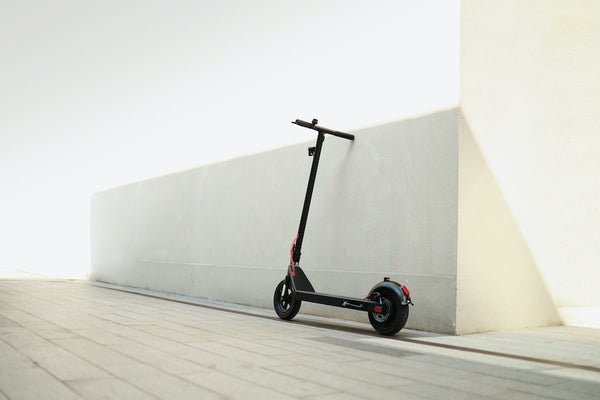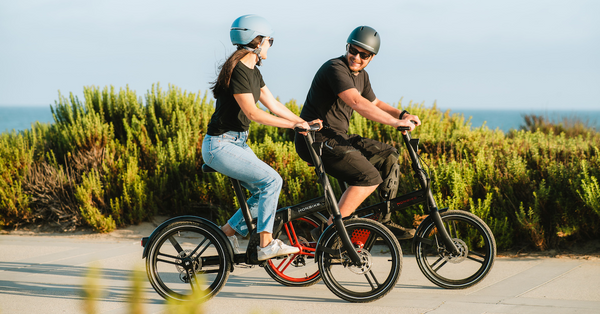Share Article
Should You Get An Electric Bike or Scooter?
Contents
Micromobility has rapidly gained popularity around the world and has become a popular mode of transport for many users. Of these, e-bikes and e-scooters are receiving the most attention and favor.
Contrary to previous years, electric bicycles and scooters are no longer mainly for sports or recreational purposes. People now commute with them while carrying out their daily activities. This could also result from the pandemic rules and restrictions. People were mandated to maintain social distancing during the period. Since these transport modes are not always crowded as public vehicles, they become the next available options. However, you may wonder if there are any differences between e-bikes and e-scooter. Read further to find out more information.
Overview of E-Scooter
Electric scooters features are a combination of motor and bicycle, with a two-wheeled mechanism. Riders either ride with their power alone or combine their strength and motor assistance. The convectional scooter was typical in past years. Contrary to the popular e-scooter in operation today, the conventional scooter lacks an electric motor, battery, and other electronic devices. In this case, the main difference between the e-scooter and the convectional type is how they are electrically powered.

E-scooters have a wide turning radius that allows riders to maneuver safely while on a trip. They also use batteries as their power source. In most cases, manufacturers use the lead-acid battery type. You can tilt the scooter backward or forward or leave it in your preferred position. The two main technicalities of e-scooters are the brake operations. Once an e-scooter has been confirmed to have two brake systems, manufacturers go ahead to install the rear and front lights.
Overview of E-bike
Electric bikes are also equipped with a motor, which is able to offer assistance for riding. However, riders do not get this assistance until they request it. The exciting aspect is that every rider is allowed to regulate the assist level generated from the e-bike. They also have a controller, which is sometimes in the frame region. The function of the controller is to update you on the battery level as you ride. Electric bicycles usually have similar features to bicycles, but lithium-ion batteries stand it out. They emit no carbon, and riders can cover longer distances with e-bikes than an e-scooter.
An e-bike motor can either be installed as a rear hub or mid-drive. Meanwhile, the location of each motor system defines its category. The mid-drive motor is an installation focused on the e-bike's central and crank. The Honbike newly launched Uni4 model uses a high ratio rear hub motor. The hub motor is highly effective and does not consume excess battery. This enables riders to cover more distances. Uni4 owners can be sure to cover 90km on a single charge.

What Are Differences?
Knowing what e-bikes and e-scooter are, let's delve into their differences.
Riding Scenarios
Although electric scooters are being adopted beyond recreational purposes, they are not used for commuting as much as e-bikes. It is rare to see e-scooters on sidewalks, but they are famous on-street bike lanes. On the other hand, e-bikes can be seen in bicycle areas and bike lanes. Manufacturers also design many different electric bikes such as mountain bikes, electric commuter bikes, electric folding bikes.
Convenience and Comfort Level
Generally, research has shown that more people prefer to use an e-bike than an e-scooter. The comfort or convenience level an individual gets from both sides varies with body weight. Some people may find it more comfortable to stand on an e-scooter, while others are more convenient with full balance while riding on the electric bicycle. Manufacturers install big tires and frames in an e-bike to support additional weights.
Riders can also choose from a wide range of available electric bicycles. Hence, there is a higher chance of selecting an e-bike that is best comfortable for you. It does not imply that e-scooters do not provide comfort as well. However, they will have a suspension system supporting the extra rider's weight. Once these suspension systems are in e-scooters, they become more challenging to carry around. However, convenience is relative, and the purpose of commuting will determine the best option for you. If you are commuting to carry out several daily activities, you need an e-bike.
Sizes
Generally, electric scooters are known to be more light-weighted than e-bikes. This is because e-bikes have additional electric components, such as the frame and handlebar. Most e-scooter users can also easily fold it and take it everywhere. Also, the weight of e-scooters is barely above 40lbs. As a result, an electric power bike that falls within this range will be considered highly minor. Meanwhile, product brand is a factor many people have failed to consider. It influences how an e-bike turns out to be, particularly the weight.
The HF01 model released by Honbike is foldable, making it easy for users to carry around, as they would have done with an e-scooter. The e-bike lacks a suspension system and uses a belt drive instead of a chain drive. It reduces the weight a rider would have experienced from taking a whole e-bike around. Also, this folding electric bike weighs 20.8kg. This is close to most e-scooters and lighter than many e-bikes you will see.
Safety and Cost
Your transportation needs should also influence how much you are willing to spend on your electric vehicles based on personal preferences and tastes. Although electric bikes are more costly than scooters, it is an item that is worth every investment. It offers excellent services to users, and you can enjoy it for commuting as much as possible. On the other hand, there are some high-standard e-scooter.
Another aspect of cost to consider is the resale value. Investing in electric bicycle will likely yield more profit because you can resell them at a higher price than e-scooters. It is also much cheaper to replace an e-scooter battery than e-bikes because they mostly use lead acid. The lead-acid battery is also cheap but not as durable as the lithium-ion battery operated in most e-bikes. However, it may take a lot to maintain an e-bike compared to an e-scooter. Most e-scooter users only replace the battery once in a while.
In terms of safety, e-bike is better than e-scooter. The latter is pretty close to the ground, so moving vehicles barely see them quickly from afar. Also, the wheels of most e-scooters are usually small, so they do not respond well to road bumps. Since e-bikes are designed with much larger wheels, they can handle rough roads or bumps.
Speed Level
Generally, an e-bike will outrun an electric scooter, primarily when used among cyclists. However, manufacturers' input also influences the weight of an e-bike. If the battery and motor added to the e-bike are heavy, it will affect its weight. The maximum speed an e-scooter can attain is usually lower than that of e-bikes. However, e-bikes' top speed varies with class and country.
The three classes of e-bikes are class one, class two, and class three. You should also find out the legal speed allowed to ride a particular e-bike class in your country. Most countries usually have a maximum speed range between 28km/h and 32km/h. For instance, the speed limit in New York is 25km/h. Hence, it beats the top speed for most countries and is also the best product for Europe residents.
Conclusion
Since electric bicycles and scooters have two wheels, it may be challenging to identify their differences. However, each has main differences that every prospective user needs to know before making a purchase. These differences have been highlighted above in this article, and hopefully, they will help you make the right choice.


























Leave a comment